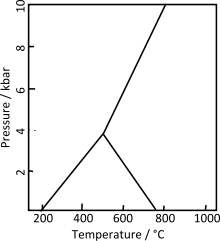Aluminium silicate
| Identifiers | |
|---|---|
3D model (JSmol) |
|
| ChemSpider | |
| ECHA InfoCard | 100.032.036 |
| E number | E559 (acidity regulators, ...) |
PubChem CID |
|
| |
| |
| Properties | |
| Al 2SiO 5 | |
| Molar mass | 162.0456 g mol−1 |
Except where otherwise noted, data are given for materials in their standard state (at 25 °C [77 °F], 100 kPa). | |
| Infobox references | |
Aluminium silicate (or aluminum silicate) is a name commonly applied to chemical compounds which are derived from aluminium oxide, Al2O3 and silicon dioxide, SiO2 which may be anhydrous or hydrated, naturally occurring as minerals or synthetic. Their chemical formulae are often expressed as xAl2O3.ySiO2.zH2O
Examples
- Al2SiO5, (Al2O3.SiO2), which occurs naturally as the minerals andalusite, kyanite and sillimanite which have different crystal structures.
- Al2Si2O5(OH)4, (Al2O3·2SiO2·2H2O), which occurs naturally as the mineral kaolinite and is also called aluminium silicate dihydrate.[3] It is a fine white powder and is used as a filler in paper and rubber and also used in paints.[3]
- Al2Si2O7, (Al2O3.2SiO2), called metakaolinite, formed from kaolin by heating at 450 °C (842 °F).[3]
- Al6SiO13, (3Al2O3.2SiO2), the mineral mullite, the only thermodynamically stable intermediate phase in the Al2O3-SiO2 system at atmospheric pressure.[4] This also called '3:2 mullite' to distinguish it from 2Al2O3.SiO2, Al4SiO8 '2:1 mullite'.
- 2Al2O3.SiO2, Al4SiO8 '2:1 mullite'.[4]
Aluminium silicate composite materials, fibres
Aluminium silicate is a type of fibrous material made of aluminium oxide and silicon dioxide, (such materials are also called aluminosilicate fibres). These are glassy solid solutions rather than chemical compounds. The compositions are often described in terms of % weight of alumina, Al2O3 and silica, SiO2. Temperature resistance increases as the % alumina increases. These fibrous materials can be encountered as loose wool, blanket, felt, paper or boards.[5]
References
- ↑ Whitney, D.L. (2002), "Coexisting andalusite, kyanite, and sillimanite: Sequential formation of three Al2SiO5 polymorphs during progressive metamorphism near the triple point, Sivrihisar, Turkey", American Mineralogist, 87 (4): 405–416
- ↑ Whitney, D.L. (2002), "Coexisting andalusite, kyanite, and sillimanite: Sequential formation of three Al2SiO5 polymorphs during progressive metamorphism near the triple point, Sivrihisar, Turkey", American Mineralogist, 87 (4): 405–416
- 1 2 3 Handbook of Inorganic Compounds, Dale L. Perry, Taylor & Francis, 2011, ISBN 978-1-4398-1461-1
- 1 2 Ceramic and Glass Materials: Structure, Properties and Processing, James F. Shackelford, R. H. Doremus, Springer, 2008, ISBN 978-0-387-73361-6
- ↑ Concise Encyclopedia of Composite Materials, ed. Anthony Kelly, MIT Press, 1989, ISBN 0-262-11145-4
External links
- Aluminum silicates at the University of Waterloo, Canada
